USS West Virginia (BB-48): The Battleship That Survived Pearl Harbor and Exacted Revenge on America’s Enemies
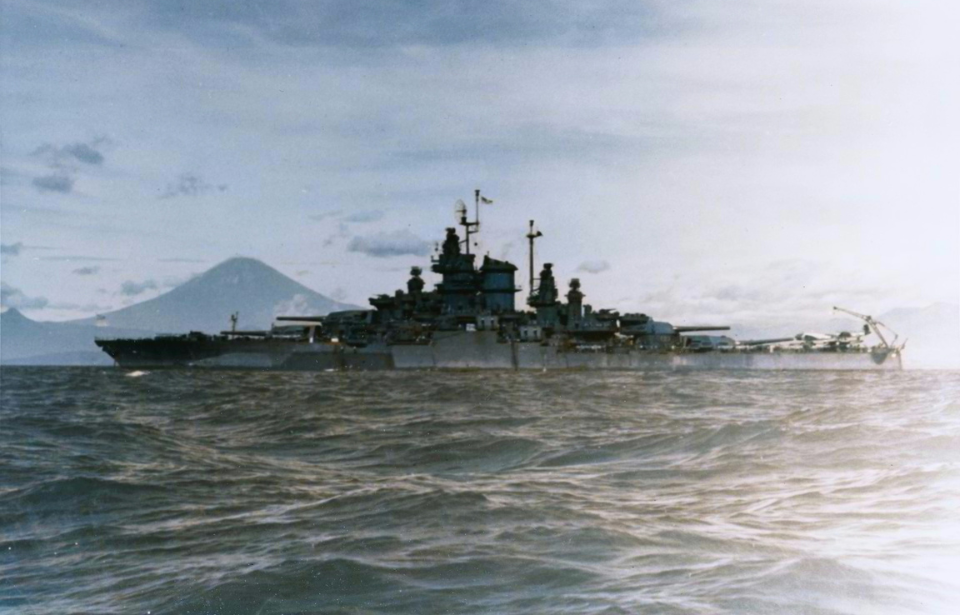
The USS West Virginia (BB-48) was one of the many American battleships to see action in the Pacific Theater during the Second World War. Miraculously being re-floated following the attack of Pearl Harbor, she went on to provide naval and fire support in Allied action against the Japanese, essentially exacting revenge for the damage and deaths caused by the enemy forces on Hawaii.
USS West Virginia (BB-48) specs.
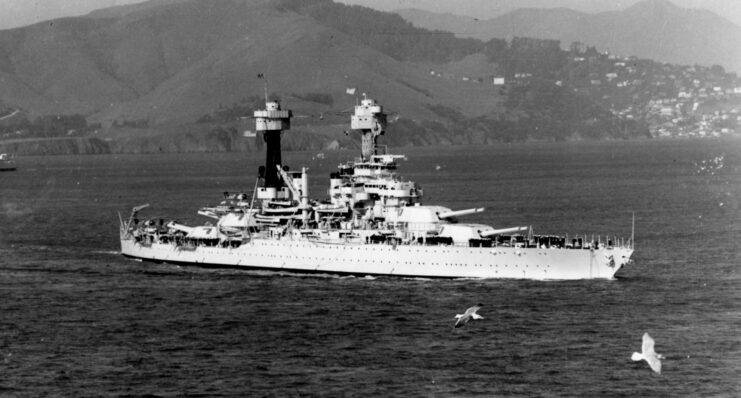
USS West Virginia (BB-48) in San Francisco Bay, California, 1934. (Photo Credit: Naval History and Heritage Command / Wikimedia Commons / Public Domain)
The USS West Virginia, a Colorado-class battleship nicknamed “Wee Vee,” was built at Newport News Shipbuilding. Laid down in 1920 and commissioned three years later, she was the last American battleship to be constructed before the restrictions under the Washington Naval Treaty were imposed.
The vessel boasted a formidable armament of eight 16-inch .45-caliber guns; sixteen five-inch .51-caliber guns; an anti-aircraft battery of eight three-inch .50-caliber guns; and two 21-inch torpedo tubes. On top of this, West Virginia‘s armor was notable, with a belt thickness of up to 13.5 inches, turret faces of 18 inches and a conning tower with 16-inches of protection, making the ship a floating fortress.
The vessel was designed with advanced watertight compartmentation, enhancing her survivability in combat. These features combined later proved crucial during West Virginia‘s service in World War II, particularly during the attack on Pearl Harbor.
Japanese attack on Pearl Harbor
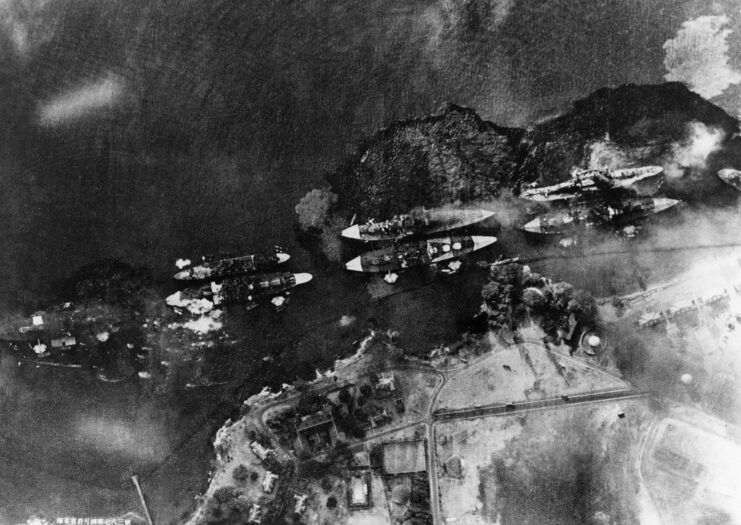
Japanese reconnaissance photo of the vessels moored at Pearl Harbor’s Battleship Row, 1941. (Photo Credit: U.S. Navy / U.S. Navy National Museum of Naval Aviation / Wikimedia Commons / Public Domain)
On the morning of December 7, 1941, the USS West Virginia was moored at Battleship Row, near the USS Tennessee (BB-43), at Pearl Harbor when the Japanese launched their attack. The vessel was hit by seven Type 91 torpedoes and two 16-inch bombs, causing severe damage. Despite the devastation, the ship’s assistant fire control officer, Lt. Claude V. Ricketts, initiated counter-flooding measures, which prevented West Virginia from capsizing.
Several crewmen distinguished themselves that morning. US Navy cook Doris “Dorie” Miller took control of an unmanned anti-aircraft gun on the vessel and helped move injured sailors to safety. West Virginia‘s commander, Capt. Mervyn S. Bennion, put his men before himself during the assault, despite being mortally wounded by shrapnel from Tennessee. He was posthumously awarded the Medal of Honor.
Tragically, three sailors – Ronald Endicott, Clifford Olds and Louis “Buddy” Costin – were trapped in an airtight storeroom and survived for 16 days within the vessel, surviving off of emergency rations. A calendar was later found near their bodies, with the days December 7-23 crossed off in red pencil.
After the attack, West Virginia was re-floated and underwent extensive repairs. She was also modernized, which saw new radar and better anti-aircraft guns installed, as well as the widening of her hull, preparing her for a return to active service in 1944.
Seeing action in the Pacific Theater
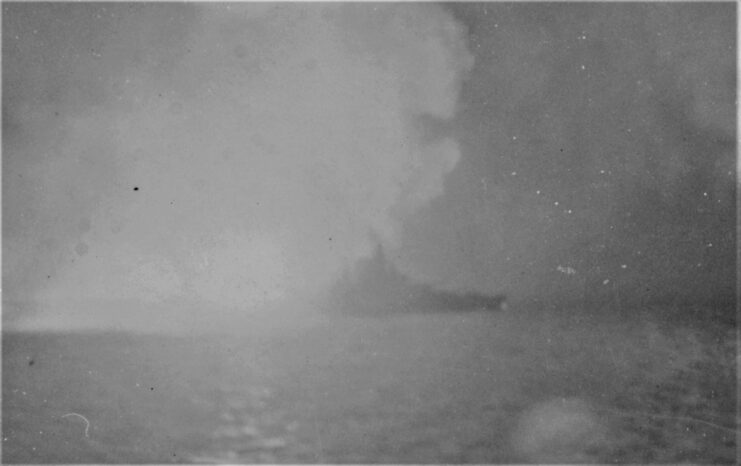
USS West Virginia (BB-48) during the Battle of Surigao Strait, 1944. (Photo Credit: U.S. Navy / Naval History and Heritage Command / Wikimedia Commons / Public Domain)
The USS West Virginia‘s return to action was marked by her involvement in the Battle of Leyte in the latter part of 1944. As part of Task Group 77.2 (TG 77.2), she played a crucial role in the shore bombardment of Japanese positions on the island.
On October 25, during the Battle of Surigao Strait, her radar-directed fire allowed West Virginia to engage and contribute to the sinking of the Japanese battleship Yamashiro. This engagement was significant, as it was the last naval battle where battleships fought each other – six on the American side versus two under the Imperial Japanese Navy (IJN).
Following the action at Surigao Strait, West Virginia went on to participate in the American landings on Mindoro Island and Luzon.
USS West Virginia (BB-48) bombarded the coast of Iwo Jima
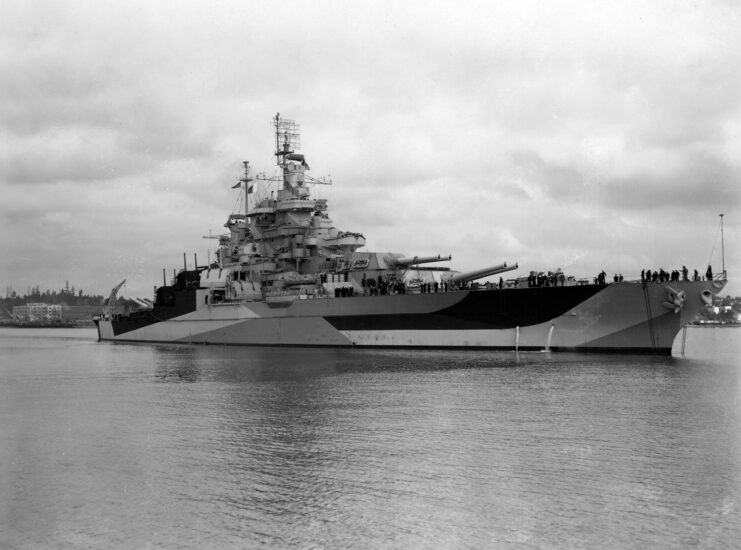
USS West Virginia (BB-48) off Puget Sound, Washington, following repair and modernization work, 1944. (Photo Credit: U.S. Navy Bureau of Ships / Naval History and Heritage Command / Wikimedia Commons / Public Domain)
In February 1945, the USS West Virginia moved to support the Fifth Fleet in the American landings on Iwo Jima. The battleship provided critical fire support for the US Marines arriving on the island, targeting Japanese fortifications, blockhouses and artillery positions; the vessel’s 16-inch guns were instrumental in neutralizing enemy defenses, aiding the ground forces in their advance.
Despite being hit by a small artillery shell that wounded one sailor, West Virginia continued on with her bombardment duties, showcasing her crew’s dedication. The support provided by the vessel proved vital to the eventual capture of Iwo Jima.
Fire support and kamikaze defense off the coast of Okinawa
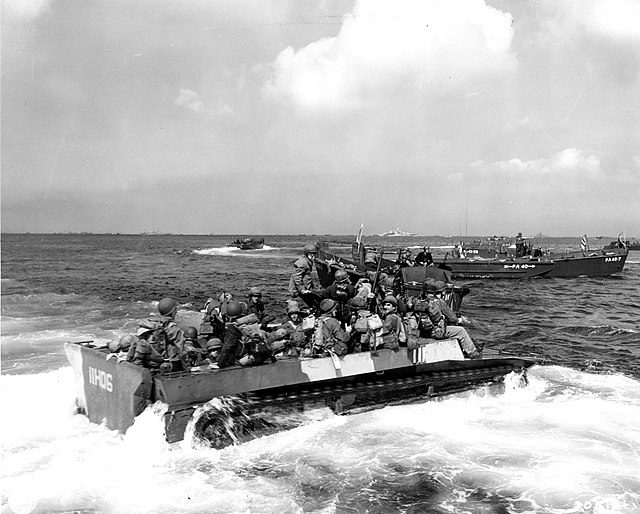
Members of the 7th Infantry Division preparing to land on Okinawa, 1945. (Photo Credit: U.S. Army Signal Corps / Wikimedia Commons / Public Domain)
The USS West Virginia‘s next major engagement was the Battle of Okinawa, in April 1945. The ship was part of Task Force 54 (TF 54) and provided pre-landing bombardment and fire support for the landing forces.
On April 1, her superstructure was struck by a kamikaze aircraft, resulting in four deaths and seven injuries. Despite this, she kept on her mission undeterred. Her anti-aircraft guns were crucial in defending against additional kamikaze attacks, and her 16-inch guns provided effective support for ground operations.
West Virginia remained off Okinawa following the initial action, delivering fire support and repelling air attacks until the island was secured.
What happened to the USS West Virginia (BB-48) after World War II?
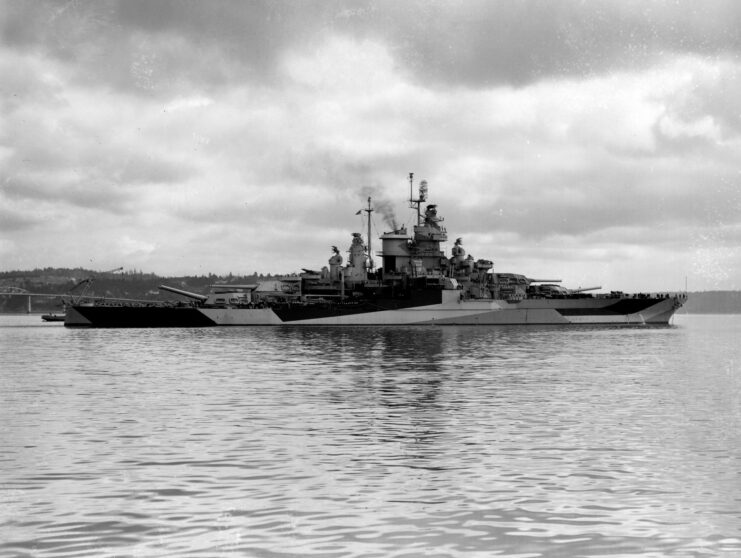
USS West Virginia (BB-48) in Puget Sound, Washington, following repair and modernization work, 1944. (Photo Credit: U.S. Bureau of Ships / Naval History and Heritage Command / Public Domain)
After World War II, the USS West Virginia attended the signing of the Japanese Instrument of Surrender in Tokyo Bay, after which she participated in Operation Magic Carpet, repatriating American servicemen from the Pacific.
The ship was decommissioned in 1947, and placed in the Pacific Reserve Fleet.
More from us: The Capture of U-505 Helped America Crack the Kriegsmarine’s Ultra-Secretive Code
In 1959, West Virginia was sold for scrap – however, several parts were preserved. One of the battleship’s anti-aircraft guns is displayed in Parkersburg, West Virginia, while her wheel and binnacle are at the Hampton Roads Naval Museum in Norfolk.





